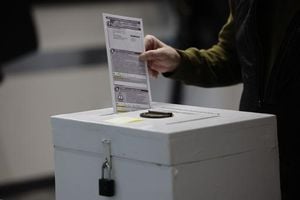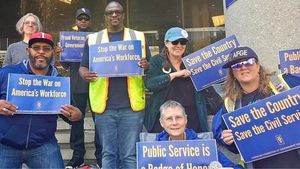In a year already marked by fierce political clashes and legal wrangling, President Donald Trump’s recent moves to assert federal control over local law enforcement have thrown Washington, DC, and California into the national spotlight. The debate over who holds the reins of public safety—local leaders or the federal government—has once again become a flashpoint, with legal, historical, and constitutional questions swirling around the president’s actions.
On August 6, 2025, President Trump reignited a long-simmering threat to have the federal government “run” Washington, DC. His comments came after a former Department of Government Efficiency employee was assaulted in an attempted carjacking, an incident he cited as evidence of lawlessness in the nation’s capital. Trump told reporters he was considering taking control of the DC Police Department and even deploying the National Guard to the city in response to what he described as rising crime.
“We’re going to look at overturning Home Rule,” Trump declared, referencing the 1973 law that gave DC some measure of self-governance. “The lawyers are already studying it.” According to CNN, such a move would not be simple: repealing the Home Rule Act and stripping DC of local control would require a vote by Congress, as explained by Jill Hasday, a constitutional law professor at the University of Minnesota Law School. “To fully remove local control over DC, Congress would have to repeal the Home Rule Act. So, if what the president has in mind is complete federal control over DC, in other words, no possibilities and no room for local control, that would require repealing the Home Rule Act,” Hasday said.
Despite Trump’s repeated assertions of a crime wave, preliminary year-to-date data from the DC Police show that crime numbers in 2025 are actually lower than last year’s. Nevertheless, the White House announced that starting the night of August 7, the federal law enforcement presence in DC would increase. Agencies involved include the US Capitol Police, FBI, US Marshals Service, DC Police, DEA, and others. Whether the National Guard would be part of this mobilization remained unclear as of Thursday night.
Trump’s authority over the DC National Guard is unique. Unlike in the fifty states, where governors command their respective National Guards, the 2,700 soldiers and airmen of the DC National Guard report directly to the president. “By statute, the president is made the commander of the DC Guard. In every other place, every other state, it’s the governor. Here, it’s the president,” explained William Banks, professor emeritus of public administration and international affairs at Syracuse University, in comments to CNN.
Trump hinted at swift action, stating, “I’m considering bringing in the National Guard, maybe very quickly, too.” Yet, experts caution that federalizing DC’s police or deploying federal troops for law enforcement is both unusual and fraught with legal complexity. Banks noted that any national authorities in DC “have the same limits on their authority that they would anywhere else. They have to respect the constitutional rights of the people so they can’t intimidate, they can’t search and seize without a reasonable suspicion of criminal wrongdoing. They can’t target individuals on the basis of their political beliefs or their political expression.”
For many DC residents, the prospect of federal troops patrolling their streets evokes memories of 2020, when Trump called in a patchwork of federal agencies to quell protests following the police killing of George Floyd. The response then included personnel from the National Guard, FBI, ICE, Secret Service, Park Police, Bureau of Alcohol, Tobacco, Firearms and Explosives, Drug Enforcement Administration, US Marshals Service, Bureau of Prisons, Customs and Border Protection, Federal Protective Service, and Transportation Security Administration. Images of authorities in full fatigues patrolling downtown DC became a symbol of the federal response, drawing sharp criticism from local officials.
“The background principle in the United States is that we like to have our laws enforced by civilians, by police, and we like it to be at the local level, people that are soldiers, cops, if you will, who are close to us. They’re our friends and neighbors. They live in our community,” Banks told CNN.
While DC grapples with the threat of federal intervention, California is embroiled in a legal battle of its own. On August 11, 2025, a bench trial is set to begin in the lawsuit filed by California Governor Gavin Newsom against President Trump over the deployment of National Guard troops to Los Angeles during protests that erupted after immigration raids on June 6. According to NewsNation, Newsom and the State of California are challenging the legality of the federal government’s actions, arguing that Trump overstepped his authority by sending troops to subdue protests without a request from the governor.
Trump justified the deployment under Title 10 of the U.S. Code, which allows the president to call National Guard units into federal service when there is a rebellion, invasion, or the danger of either. However, Newsom’s lawsuit contends that none of those conditions existed. The legal complaint also cites the Posse Comitatus Act, an 1878 law that forbids the U.S. military from participating in civilian law enforcement on U.S. soil, except in cases “expressly authorized by the Constitution” or by Congress.
Judge Charles R. Breyer, who will preside over the trial, has already sided with California in a preliminary June 12 ruling, ordering the return of the troops to state control. “His [Trump’s] actions were illegal—both exceeding the scope of his statutory authority and violating the Tenth Amendment to the United States Constitution. He must therefore return control of the California National Guard to the Governor of the State of California forthwith,” Breyer wrote in his decision.
Trump’s legal team maintains that the deployment was justified under the Insurrection Act, which gives the president broad powers to suppress rebellion, violence, or enforce the law in certain situations. At the time of the protests, Trump took to social media to label demonstrators as “paid insurrectionists” and insisted they “should be in jail.” Newsom, however, argues that the requirements for invoking the Insurrection Act were not met, especially since he did not request federal intervention.
The outcome of the California lawsuit could have far-reaching implications for the balance of power between state and federal governments. As NewsNation notes, the trial will likely set a precedent for how—and when—the president can override state leaders with military action in times of unrest. Both the legal and political stakes are high: a ruling in favor of California could reaffirm states’ rights and limit the president’s ability to unilaterally deploy troops, while a decision favoring Trump could expand executive authority in ways not seen since the Civil Rights era.
Back in Washington, DC, experts and local officials continue to question the necessity and legality of increased federal involvement. Hasday, the constitutional law professor, observed, “It’s not clear that DC is, in fact, undergoing a public safety crisis.” She pointed out that while violent crime exists in DC, as it does everywhere, there is little evidence to suggest the situation exceeds the capacity of local police.
As the nation watches these two high-profile confrontations unfold, the fundamental question remains: Who should control America’s streets in times of crisis—the people who live there, their elected local leaders, or the federal government? The coming weeks could provide answers that will shape the country’s approach to law enforcement and civil liberties for years to come.
Events in DC and California serve as a stark reminder that the boundaries of federal power and local autonomy are not just legal abstractions—they are issues that affect the daily lives of millions, and their resolution will have consequences that ripple far beyond the current headlines.




